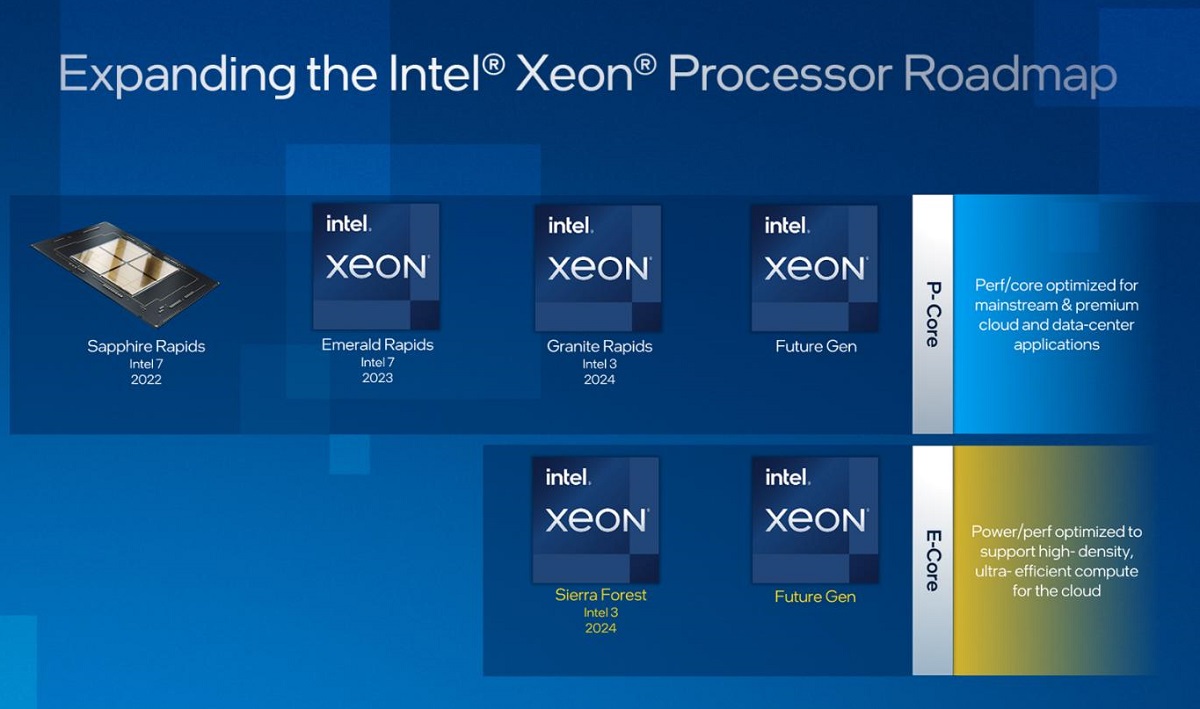Intel is hoping for a silver lining on server chips amid a disastrous quarterly earnings report and a grim business outlook.
“I really feel like the worst of our execution is behind us” on server chips, said Intel CEO Pat Gelsinger, during the third quarter earnings call on Thursday.
The company is ramping up shipments of its upcoming 4th Generation Xeon Scalable chips, codenamed Sapphire Rapids, though the chips have yet to be formally launched.
“We expect this will be our fastest ever Xeon to a million units, and we’re going to push that quite aggressively in the factories,” Gelsinger said.
Intel resolved issues with Sapphire Rapids, which had been delayed, which had a positive knock on effect on the chip’s successors.
Emerald Rapids, which is due to ship next year, “is looking good,” and the successor, Granite Rapids, “is very healthy, running multiple operating systems across many configurations,” Gelsinger said.

Granite Rapids will ship in 2024, alongside a Xeon server chip codenamed Sierra Forest, which will be the first server chip with energy-efficient cores. The power-saving cores, also called “e-cores” by Intel, is already available in Core PC chips codenamed Alder Lake.
Emerald Rapids is expected to be made on the Intel 7 process, which is an optimized version of the 10-nanometer node. Granite Rapids will be made on Intel 3 process, which will include significant power and performance improvements. “The first stepping of Granite Rapids is out of the fab, and yielding well,” said Gelsinger.
“So the next three generation products are all making very good milestones,” Gelsinger said, adding “Intel 4 and 3 are our first nodes deploying EUV and will represent a major step forward in terms of transistor performance per watt and density.”
The server chips will be back on a predictable release schedule after multiple delays to Sapphire Rapids, Intel said.
“As we ramp these products, it’s all about having the best product to gain share, to gain ASP, to improve the margins of the business and we now feel like our portfolio [is] taking shape to accomplish exactly that,” Gelsinger said.
Gelsinger acknowledged that poor execution on server chips allowed competitors to gain market share, and said “we want it to be tracking in line with our expectations and we are encouraged by good execution in the quarter against our product roadmap.”
Intel will be aggressive and “fight for every socket,” Gelsinger said, adding “we have to reestablish ourselves.”
Intel had an x86 server chip market share of 86.1% during the second quarter this year, declining from a 90.5% market share in the same quarter last year, according to numbers from Mercury Research.
AMD’s market share was 13.9% during the second quarter this year, increasing from 9.5% in last year’s second quarter.
AMD this year notched a big server win with Meta, which is building out its infrastructure to support new AI applications, and “would require more expensive servers and networking equipment,” said Meta’s chief financial officer Dave Wehner, in a quarterly earnings call this week.
Nonetheless, Gelsinger acknowledged that its Datacenter and AI Group could take a hit as demand for server chips could be impacted by the economic slowdown and softness in the enterprise and cloud markets.
Amazon’s AWS and Microsoft’s Azure did not show growth in recent earnings, and datacenter upgrades are hitting the bottom of a typical two-year cycle, said Dean McCarron, the founder of Mercury Research.
Datacenter upgrade cycles typically last about two years, and hit a peak at the beginning of the year when the demand for server chips is high. Datacenter providers start with the “build” cycle to build out more capacity than is needed, and then go through an “absorb” cycle to make sure the 100% of server capacity is met.
The demand for server chips slows down the absorb cycle as new servers are not deployed. Once 100% of the server capacity in a datacenter is met, datacenter companies go into build mode and launch new sites, which is when demand for chips again goes up, McCarron said.
“We’re looking at more of an extreme cycle because of the absorb cycle and the macroeconomic headwinds,” McCarron said.
The economic slowdown will not stop Intel from releasing new server chips, as the company wants to be ready for server upgrades, McCarron said.
Intel’s earnings report was grim. Intel reported net revenue of $15.3 billion for the third fiscal quarter of 2022, down by 20% from the same quarter last year. The company eked out a net profit of $1 billion, down by 85% compared to the same quarter last year.
Revenue for the DCAI group was $4.2 billion, down 27% from the same quarter last year. Revenue for the Client Computing Group, which deals in PC chips, was $8.1 billion, down 17% from the year-ago quarter.
Intel officials hinted at a possible bloodbath among internal operations until 2025 as it looks to cut costs, trim operations and reduce efficiencies in its transition to a manufacturing-first organization.
Intel is looking to implement four nodes by 2025 to regain its manufacturing leadership over rivals Taiwan Semiconductor Manufacturing Co. and Samsung.
The company is looking to save $3 billion in fiscal 2023, and up to $10 billion by 2025.
“These savings will be realized through multiple initiatives to optimize the business, including portfolio cuts, right sizing of our support organizations, more stringent cost controls in all aspects of our spending and improved sales and marketing efficiency,” said Dave Zinsner, chief financial officer at Intel during the earnings call.
Gelsinger said the company is working through the turnaround with the end goal of regaining manufacturing leadership by 2025.
“Our efforts across manufacturing, design, products and foundry are well on their way to driving our transformation,” Gelsinger said.




























































